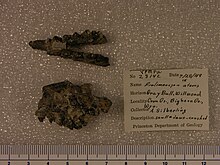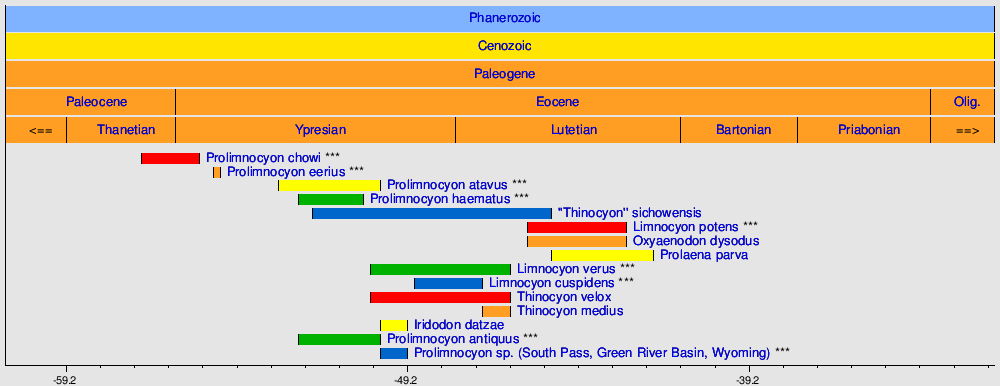Limnocyonidae
Limnocyonidae (Лимнокионидае — „мочварни пси”) је изумрла породица плаценталних сисара из изумрлог реда Hyaenodonta, која је у периоду од касног палеоцена до касног еоцена настањивала подручје Азије и Сјеверне Америке.[5][6][7][8][9][10][11] Ову породицу сисара су чинили родови Iridodon, Oxyaenodon, Prolaena и Thinocyon, парафилетски родови Limnocyon и Prolimnocyon, као и несврстана врста "Thinocyon" sichowensis. Стручни назив за чланове ове породице сисара је лимнокиониди.
| Limnocyonidae | |
|---|---|

| |
| реконструкција изгледа врсте Limnocyon verus | |

| |
| лобање врсте Prolimnocyon antiquus | |
| Научна класификација | |
| Домен: | Eukaryota |
| Царство: | Animalia |
| Тип: | Chordata |
| Класа: | Mammalia |
| Ред: | †Hyaenodonta |
| Породица: | †Limnocyonidae Wortman, 1902[1] |
| Типски род | |
| †Limnocyon Marsh, 1872
| |
| Родови | |
| |
| Синоними | |
Етимологија назива
уреди| Породица: | Поријекло назива од: | Значење назива: |
|---|---|---|
| Limnocyonidae |
|
мочварни пси |
Опис
уредиВрсте из породице Limnocyonidae су посједовале само два пара кутњака (M1/m1 и M2/m2) у горњој и доњој вилици,[12] док је трећи пар кутњака (M3/m3) није присутан у вилицама или је знатно умањен (тј. редукован).[7][12] Ове врсте сисара су се кретале плантиградно, биле су способне да се пењу по дрвећу и живјеле су слично као данашње цибетке, мунгосе и куне.
Систематика
уредиИсторија класификације
уредиПородица Limnocyonidae је раније, као потпородица Limnocyoninae, била уврштавана као представник изумрле породице Hyaenodontidae,[13] али је у каснијим истраживањима уврштена као засебна породица сисара унутар изумрлог реда Hyaenodonta.[14][15][16] Представници потпородице Machaeroidinae су у ранијим класификацијама (као племе Machaeroidini) били уврштени унутар потпородице Limnocyoninae,[17][18][6][19] но у каснијим истраживањима су препознати као представници изумрле породице Oxyaenidae.[20][21]
Класификација
уредиКласификација породице Limnocyonidae:
| Род: | Врсте: |
|---|---|
| †Iridodon (Morlo & Gunnell, 2003) |
|
| †Limnocyon (парафилетски род) (Marsh, 1872) |
|
| †Oxyaenodon (Matthew, 1899) |
|
| †Prolaena (Xu, 1979) |
|
| †Prolimnocyon (парафилетски род) (Matthew & Granger, 1915) |
|
| †Thinocyon (Marsh, 1872) |
|
| Incertae sedis: |
|
Филогенија
уредиДоље приказан кладограм представља филогенетске везе породице Limnocyonidae.[22][12][14][15][16][23][24]
| †Hyaenodonta |
|
|||||||||||||||||||||||||||||||||||||||||||||||||||||||||||||||||||||||||||||||||||||||||||||||||||||||||||||||||||||||||||||||||||||||||||||||||||||||||||||||||||||||||||||||||||||||||||||||||||||||||||||||||||||||||||||||||||||||||||||||||||||||||||||||||||||||||||||||||||||||||||||||||||||||||||||||||||||||||||||||||||||||||||||||
Временска распрострањеност
уредиУнутар реда Hyaenodonta
уреди
Унутар породице Limnocyonidae
уреди
Види још
уредиРеференце
уреди- ^ J. L. Wortman (1902.) "Studies of Eocene Mammalia in the Marsh Collection, Peabody Museum." The American Journal of Science, series 4 13:197-206
- ^ L. Van Valen (1966.) "Deltatheridia, a new order of Mammals." Bulletin of the American Museum of Natural History 132(1):1-126
- ^ A. V. Lavrov (1999.) "Adaptive Radiation of Hyaenodontinae (Creodonta, Hyaenodontidae) of Asia." in 6th Congress of the Theriological Society, Moscow, April 13–16, p. 138 [in Russian].
- ^ Savage, R. J. G. (1973). „Megistotherium, gigantic hyaenodont from Miocene of Gebel Zelten, Libya”. Bulletin of the British Museum (Natural History), Geology. 22 (7): 483—511.
- ^ Gazin, Charles Lewis (17. 1. 1962). „A further study of the lower Eocene mammalian faunas of southwestern Wyoming” (PDF). Smithsonian Miscellaneous Collections. Washington, D.C.: Smithsonian Museum. стр. 1—98.
- ^ а б McKenna, Malcolm C.; Bell, Susan K. (1997). Classification of Mammals Above the Species Level. New York: Columbia University Press. ISBN 978-0-231-11012-9. Приступљено 16. 3. 2015.
- ^ а б G. F. Gunnell (1998.) "Creodonta". In C. M. Janis, K. M. Scott, and L. L. Jacobs (eds.), "Evolution of Tertiary Mammals of North America, Volume 1: Terrestrial Carnivores, Ungulates, and Ungulate like Mammals", Cambridge University Press, 703 pages ISBN 9780521355193
- ^ S. Peigné, M. Morlo, Y. Chaimanee, S. Ducrocq, S. T. Tun and J. J. Jaeger (2007.) "New discoveries of hyaenodontids (Creodonta, Mammalia) from the Pondaung Formation, middle Eocene, Myanmar—paleobiogeographic implications." Geodiversitas 29(3):441-458
- ^ Michael Morlo; Katharina Bastl; Wu Wenhao; Stephan F. K. Schaal (2014). „The first species of Sinopa (Hyaenodontida, Mammalia) from outside of North America: implications for the history of the genus in the Eocene of Asia and North America”. Palaeontology. 57 (1): 111—125. doi:10.1111/pala.12052.
- ^ Matthew R. Borths; Patricia A. Holroyd; Erik R. Seiffert (2016). „Hyainailourine and teratodontine cranial material from the late Eocene of Egypt and the application of parsimony and Bayesian methods to the phylogeny and biogeography of Hyaenodonta (Placentalia, Mammalia)”. PeerJ. 4: e2639. PMC 5111901 . PMID 27867761. doi:10.7717/peerj.2639.
- ^ Floréal Solé; Bastien Mennecart (2019). „A large hyaenodont from the Lutetian of Switzerland expands the body mass range of the European mammalian predators during the Eocene”. Acta Palaeontologica Polonica. 64 (2): 275—290. doi:10.4202/app.00581.2018 .
- ^ а б в M. Morlo and G. F. Gunnell (2005.) "New species of Limnocyon (Mammalia, Creodonta) from the Bridgerian (middle Eocene)." Journal of Vertebrate Paleontology 25(1):251-255
- ^ Floréal Solé (2013). „New proviverrine genus from the Early Eocene of Europe and the first phylogeny of Late Palaeocene–Middle Eocene hyaenodontidans (Mammalia)”. Journal of Systematic Palaeontology. 11 (4): 375—398. doi:10.1080/14772019.2012.686927.
- ^ а б Borths, Matthew R.; Stevens, Nancy J. (2017). „Deciduous dentition and dental eruption of Hyainailouroidea (Hyaenodonta, "Creodonta," Placentalia, Mammalia)”. Palaeontologia Electronica. 20 (3): 55A. doi:10.26879/776 .
- ^ а б Matthew R. Borths; Nancy J. Stevens (2019). „Simbakubwa kutokaafrika, gen. et sp. nov. (Hyainailourinae, Hyaenodonta, 'Creodonta,' Mammalia), a gigantic carnivore from the earliest Miocene of Kenya”. Journal of Vertebrate Paleontology. 39 (1): e1570222. doi:10.1080/02724634.2019.1570222.
- ^ а б Floréal Solé; Bernard Marandat; Fabrice Lihoreau (2020). „The hyaenodonts (Mammalia) from the French locality of Aumelas (Hérault), with possible new representatives from the late Ypresian”. Geodiversitas. 42 (13): 185—214. doi:10.5252/geodiversitas2020v42a13.
- ^ Charles Lewis Gazin (1946.) "Machaeroides eothen Matthew, the sabertooth creodont of the Bridger Eocene" Proceedings of the United States National Museum. 96 (3202):335–347, 2 pls.
- ^ L. Van Valen (1967.) "New Paleocene insectivores and insectivore classification." Bulletin of the American Museum of Natural History 135(5):217-284
- ^ Egi, Naoko (2001). „Body Mass Estimates in Extinct Mammals from Limb Bone Dimensions: the Case of North American Hyaenodontids”. Palaeontology. 44 (3): 497—528. doi:10.1111/1475-4983.00189.
- ^ Shawn P. Zack (2019). „A skeleton of a Uintan machaeroidine 'creodont' and the phylogeny of carnivorous eutherian mammals”. Journal of Systematic Palaeontology. 17 (8): 653—689. doi:10.1080/14772019.2018.1466374.
- ^ Shawn P. Zack (2019). „The first North American Propterodon (Hyaenodonta: Hyaenodontidae), a new species from the late Uintan of Utah”. PeerJ. 7: e8136. PMC 6876642 . PMID 31772846. doi:10.7717/peerj.8136.
- ^ M. Morlo & G. F. Gunnell (2003.) "Small Limnocyonines (Hyaenodontidae, Mammalia) From the Bridgerian Middle Eocene of Wyoming: Thinocyon, Prolimnocyon And Iridodon, New Genus." Contributions from the Museum of Paleontology, University of Michigan 31(2):43-78
- ^ Solé, F.; Morlo, M.; Schaal, T.; Lehmann, T. (2021). „New hyaenodonts (Mammalia) from the late Ypresian locality of Prémontré (France) support a radiation of the hyaenodonts in Europe already at the end of the early Eocene”. Geobios. 66-67: 119—141. doi:10.1016/j.geobios.2021.02.004.
- ^ Averianov, Alexander; Obraztsova, Ekaterina; Danilov, Igor; Jin, Jian-Hua (2023). „A new hypercarnivorous hyaenodont from the Eocene of South China”. Frontiers in Ecology and Evolution. 11. ISSN 2296-701X. doi:10.3389/fevo.2023.1076819/full.